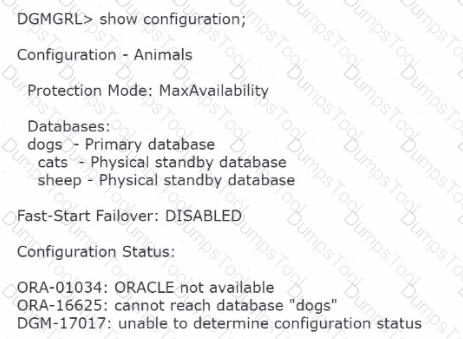Which THREE statements are true…….. open in real time query mode, which becomes a new.
Your Data Guard environment contains a four-instance RAC primary database whose SID is PROD and a RAC physical standby database whose std is PROD_SBY.
Examine the command executed on a node of the primary database cluster to create a service OLTPWORKLOAD that the applications will use to connect to the database when it is in the FRlMARYTclatabase role:
srvctl add service -db PROD -service oltpworkload -role PRIMARY -failovertype SESSION -failovermethod BASIC -failoverdelay 10 -failoverretry 150
The service is then started
Consider this list of tasks:
1. On a node of the standby database cluster execute:
srvctl add service -db PROD_SBY -service oltpworkload -role PRIMARY -failovertype SESSION -failovermethod BASIC -failoverdelay 10 -failoverretry 150
2. On the primary database, create the oltpworkload database service using the dbms_service.create_service procedure.
3. Configure tap for clients in the tnsnames.ora files.
4. Make sure clients use the OLTPWORKLOAD service to connect to the database instances.
5. On the standby database, create the oltpworkload database service using the dbms_service.create_servi;l procedure.
Identify the required steps to configure and use Transparent Application Failover (taf).
Which four factors can influence the rate of SQL apply on a logical standby database?
Examine the Data Guard configuration:
DGMGRL> show configuration;
Configuration - Animals
Protection Mode: MaxAvailability
Databases:
dogs - Primary database
cats - Snapshot standby database
sheep - Snapshot standby database
Fast-Start Failover: DISABLED
Configuration Status:
ORA-01034: ORACLE not available
ORA-16625: cannot reach database "dogs"
DGM-17017: unable to determine configuration status
ou wish to perform a failover to sheep. Which command, or sequence of commands, should you issue to the broker before executing failover to sheep; using the broker?
Examine the Data Guard configuration after an accidental switchover to Sheep:
DGMGRL> show configuration;
Configuration - Animals
Protection Mode: MaxAvailability
Databases:
sheep - Primary database
dogs - Logical standby database
cats - Physical standby database (disabled)
ORA-16795: the standby database needs to be re-created
Fast-Start Failover: DISABLED
Configuration Status:
SUCCESS
Which three statements will be true after a switchover to Dogs?
A customer asks for your recommendation regarding this requirement:
1. We plan to have a Data Guard Configuration with one primary database and one physical standby database.
2. We want zero data loss in case of a disaster involving the loss of one component.
3. We want to do Real Application Testing occasionally on the Standby Database.
Which solution, if any, satisfies these requirements?
You are licensed to use Oracle Active Data Guard.
Which TWO statements are true after enabling block change tracking on a physical standby database?
Which statement is true regarding Oracle Net connectivity for a Data Guard Broker configuration?
Your Data Guard environment consists of these components and settings:
1. A primary database
2. Two remote physical standby databases
3. The redo transport mode is set to sync
4. Real-time query is enabled for both standby databases
5. The DB_BLOCK_CHECKING parameter is set to TRUE on both standby databases
You notice an increase in redo apply lag time on both standby databases.
Which two would you recommend to reduce the redo apply lag on the standby databases?
Which two are true about database roles in an Oracle Data Guard configuration?
Which TWO statements are true about database parameters for databases in a Data Guard environment?
Which two statements are true regarding asynchronous redo transport in a Data Guard
Attempting to start the observer raises an error:
DGMGRL> start observer;
DGM-16954: Unable to open and lock the Observer configuration file
Failed.
Identify two possible ways to start the observer successfully.
Which FOUR database parameters might be affected by or influence the creation of standby databases?
Examine the Data Guard configuration:

Which three will be true after a successful failover to Cats?
Which two are true concerning the configuring of Flashback database in a Data Guard environment?
Which THREE are among the various tasks performed by the Data Guard Monitor (DMON) process?
Which two statements are true when using non-rolling release upgrades in a Data Guard environment?
Which three are true regarding prerequisites for a logical standby database as a disaster recovery solution?
Your Data Guard environment consists of these components and settings:
A primary database supporting an OLTP workload
A remote physical standby database
Real-time query is enabled
The redo transport mode is set to SYNC
The protection mode is set to Maximum Availability
Which two statements are true regarding the DelayMins database property for the standby database?
Examine this validate command:
DGMGRL> VALIDATE DATABASE VERBOSE "
Which THREE statements are TRUE?
You created two remote physical standby databases using SQL and RMAN.
The primary database is a four-instance RAC database and each physical standby database has two instances.
Roles-based services are used for client connectivity and have been defined in the Grid Infrastructure.
Consider these operational requirements:
• The ability to manage multiple standby databases with a single tool
• The simplification of switchovers, failovers, reinstatements, and conversions to and from snapshot standby databases
• The automation of failovers to a specified target standby database
Which TWO tools can be used to fulfill these requirements7